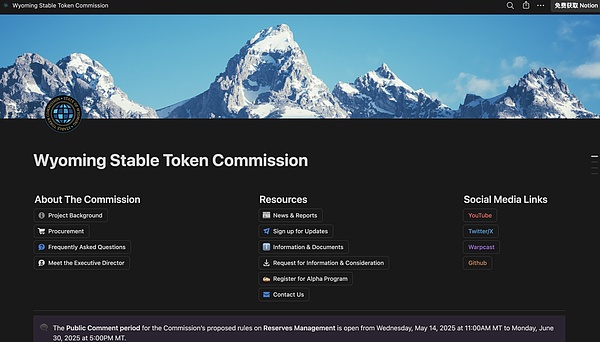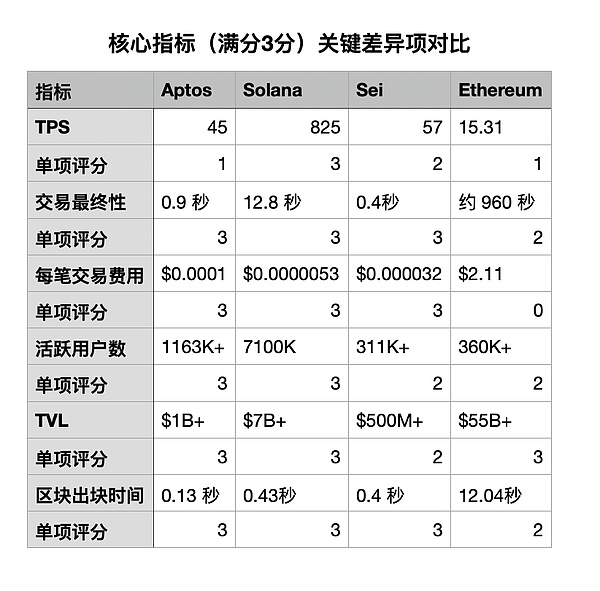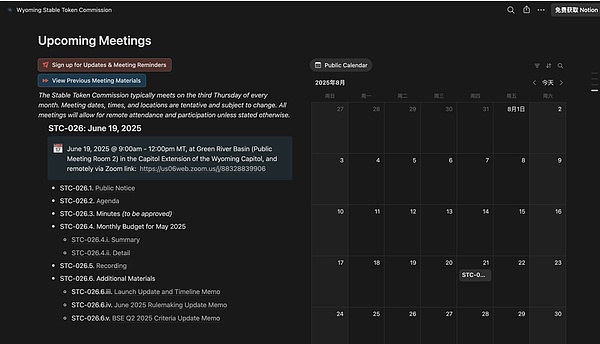I saw the news last night that the U.S. state of Wyoming held a public scoring event to select a public chain for its upcoming stablecoin WYST. In the end, 11chains were shortlisted, AptosandSolanawith 32 leaf="">tied for first place with points, Seiclosely followed with 30points, Ethereumand a number of L2with points or lower This may be quite different from the public chain ecological activity and currency price that everyone feels in daily life. How is this score scored? I was very curious, so I studied with GPT teacher. 1/ First of all, I would like to praise the US state government for building in public. The Wyoming Stablecoin Committee behind the stablecoin WYST was established in March 2023 in accordance with the state's Stable Token Act. The committee has a public notiondocument, which contains a project profile, meeting calendar and minutes, grading criteria results and memo, Q&A, contact information, and lists its own YouTubechannel, account, The Warpcast account and Github account are more serious and transparent than many careless projects nowadays.

2/2024YearQ4The committee preliminarily selected28public chains, and first screened out14items; secondly, 9 indicators (3 points for each), including network stability, number of active users, TVL, stablecoin market value, TPS, transaction fees, transaction finality time, block generation time, and whether it is registered in Wyoming; finally, 5 additional benefits each with 2 points (Privacy, Interoperability, Smart Contracts/Programmability, Use Cases, Partners) and 6 additional risks each with -2 points (Privacy, Interoperability, Smart Contracts/Programmability, Use Cases, Partners) Entity violations, team violations, history of security vulnerabilities, poor network availability, lack of bug bounty, lack of code maintenance) will be scored.
The final recommendation will be5BarLayer 1Main chain: Solana (32points), Avalanche(26 text="">points), Stellar(24points), Sui(26points) and 4eligibleLayer 2Chain: Arbitrum(26points), Base(points) are included in the “Candidate Blockchain”.
3/Aptos and SEI were actually newly included in the selection in Q1 this year. This quarter, the committee updated the selection criteria and added a new item, “whether there is vendor support”, to the right and wrong criteria, which means “the blockchain must have support for development, auditing, and infrastructure deployment from the committee’s partner vendors. This can be undertaken by the foundation, subject to approval.” Another item was updated, “the chain must be fully indexed and supported by the committee’s partner on-chain analysis platforms (such as Chainalysis, TRM Labs)”.
Two new items have been added to the additional advantage points, namely:
- Emerging Market Trends:Whether it carries emerging track projects such as AI, DePIN, virtual reality, and game assets
- Foundation Support:Whether the foundation can support one or all of the three items of technology development, WYST liquidity, and market promotion
In this scoring,
Aptos
and SEIrespectively scored 32points and 30points, and were therefore added to the candidate chains. 4/ So how did this score difference come about? I first made a comparison chart of the key differences around the core indicators. Please note that since the new round of scoring did not re-score the 9 public chains that had been selected before, some of the data here is from the end of 2024, not the latest.

It can be seen that Ethereum's TVL is leading by a cliff, but in terms of transactions per second (TPS), transaction finality time, transaction fees, and block time, this decentralized chain still suffers a lot. It can also be seen here that the diversion of Layer2 has caused the number of active users on the Ethereum main network to be only at the same level as SEI, far behind Aptos and Solana.
But Aptos how did it manage to tie with Solanafor the highest score? I found that, on the one hand, Aptos is indeed very balanced, with strong compliance, fast speed, low cost, and relatively stable network. On the other hand, the second round of scoring added two points in the additional advantage bonus items, but Solana did not re-participate in this round of scoring. If these two items are removed, the actual highest score should still be Solana.
5/It is worth noting here that although Ethereum has always advertised itself as the best choice for carrying real assets on the chain, when it comes to technology selection at the government level, the permissionless network is a threshold, and it is fine as long as you pass it. Network stability only accounts for one of the core indicators; the lack of technical barriers and insufficient network availability are risk deduction items. Solana was offline and crashed, which deducted 1 point each, but it had little impact on the overall situation; there is no score for the degree of decentralization. Instead, the state government pays more attention to whether it can be frozen and whether it has an entity in Wyoming;
The majority of core indicators are performance, cost and scale.
Of course, the issuance of this state-level stablecoin has stated from the beginning that it will abide by the principle of "multi-chain support and technology neutrality". In the future, it will continue to update the rules and collect feedback. At the same time, it welcomes chains that have not been shortlisted to continue to submit applications to participate in the selection. Therefore, public chains that have entered the candidate list or even those that have not yet entered the list have a chance in theory.
6/In addition to the selection of public chains, this Wyoming state-level stablecoin project is also worth noting. As the first state in the United States to plan to issue a stablecoin, WYST was originally scheduled to be launched before July 4, but at the regular meeting at the end of May, this timeline has been postponed to the third quarter of 2025, and the new proposed date is August 20. Subsequent work also involves public comment collection and final approval of reserve management rules, formulation of the committee's exclusive general ledger/chart of accounts, establishment of trust accounts and liquidity fund accounts with third-party custodians, and contact with licensed service providers, including centralized exchanges, payment platforms, digital wallets, and market makers, for the purchase and resale of WYST, etc.

Ultimately, the reserve behind the stablecoin will be managed by Franklin Templeton Fund, Chainalysis will be responsible for on-chain analysis, and will work with LayerZero and Fireblocks to complete the integration, complete the decentralized verification network and official website launch, deploy the WYST contract to the mainnet before August 20, and then issue a public statement at the Wyoming Blockchain Symposium to officially release it.
In addition to Wyoming, Nebraska has passed its "Financial Innovation Act" to authorize an entity called Telcoin to issue a state-backed stablecoin, temporarily called eUSD. Tinian Island in the Northern Mariana Islands, an overseas territory under the jurisdiction of the United States, attempted to issue a US dollar stablecoin called Marianas US Dollar (MUSD), which was vetoed by the governor in April this year, and the Senate overturned the governor's veto in May.
This scene of US states and major companies gearing up to issue their own stablecoins easily reminds people of the free banking era from 1837 to 1866, when states, cities, private banks, railways and construction companies, shops, restaurants, churches and individuals issued about 8,000 different currencies by 1860, with a wide variety and lack of unified standards. The picture in this article is
a private currency of $1 issued by the New Jersey Delaware Bridge Company from 1836 to 1841. 7/Recently, there has been a lot of discussion about RMB stablecoins, and some large companies are also eager to try. After the question of whether to have it, the next question may be which chain to run on.Whether to launch a dedicated chain, use the alliance chain of large companies such as Ant Chain and JD Chain, connect to common international public chains, or use some domestic public chains such asHashkey Chain、Confluxand so on.This issue is a new topic for governments and companies in China, the United States, and other countries around the world. Wyoming's scoring and public disclosure system may not be perfect, but it serves as a model for later generations. We should see more interesting governance progress in the future.
 Catherine
Catherine





